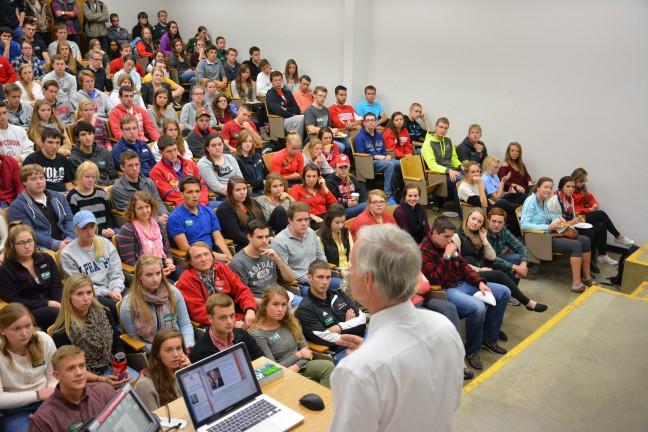When U.S. Sen. Ron Johnson, R-Oshkosh, entered a packed University of Wisconsin lecture hall to address the UW College Republicans in September, he called the amount of students there “pretty encouraging.”
Johnson — who’s been rated among the most conservative U.S. senators — was entering a lecture hall in a campus that’s seen as mostly liberal.
“This is one of the best turnouts I’ve had, so that’s why I’ve got a big smile on my face,” Johnson told The Badger Herald after the event. “This is encouraging to me.”
Tuesday’s election results suggest Johnson had a reason to be encouraged.
Republican Gov. Scott Walker, who was re-elected Tuesday, was far from winning the UW campus vote, but he came much closer than Republicans — even himself — have come in recent years.
The Badger Herald compared three campus-area wards that didn’t change significantly after the city redrew its voting wards. The city redraws its voting wards every 10 years following the U.S. census.
The three wards are the ward containing Sellery and Witte Halls and the Lucky apartments; the ward containing Liz Waters and Chadbourne Halls; and the ward that spans the Spring Street area known as the “sophomore slums.”
Walker got 42 percent of the vote in those three wards, up from the 33 percent of the vote he got in those wards when he was elected governor in 2010. During his 2012 presidential run, Republican Mitt Romney got 30 percent of the vote in those three wards.
In the ward containing Sellery and Witte Hall, Democrat Mary Burke only beat Walker by 22 votes, getting 49.62 percent of the vote in that ward compared to Walker’s 47.96 percent.
“I’m shocked,” UW College Republicans Chair Charlie Hoffmann said. “I am shocked at how close some of the campus wards were.”
The wards The Badger Herald compared are largely made up of freshmen and sophomores, some in dorms and some in apartments. Those students tend to vote more Republican than older students who live in off-campus housing, according to Ald. Mike Verveer, District 4, who has been the chief inspector at the Gordon Commons polling location for more than 20 years.
“The pattern is Democrats and Republicans do tend to be more competitive in some of these campus wards,” Verveer said. “You get off campus, it’s much less so.”
For example, Walker got 35 percent of the vote in the off-campus 49th ward, which votes at Madison Fresh Market and includes mostly students in apartments and houses. That percentage fits the typical voting pattern at UW, which consistently sees about 30 percent of students voting for Republicans.
Matt Walker, the governor’s son and the chair of the Wisconsin Federation of College Republicans, said Republicans did better in campuses across the state, in part because they’re “just more organized” this year.
The candidates on the ballot were also more appealing to students, he added, highlighting a tuition freeze at UW System campuses as one example.
“These candidates have done a lot for students,” Walker said. “They’ve done a lot for young people. … The tuition freeze helped a lot of students, especially those at the UW System.”
Hayley Young, the chair of UW College Democrats, criticized Walker’s higher education record, noting that the tuition freeze also came with cuts to the UW System. U.S. Rep. Mark Pocan, D-Madison, has described Walker’s tuition freeze as “putting lipstick on the pig.”
Young attributed the increase in campus voting for Republicans to the UW freshman class being made up more of in-state freshmen than in the past, which especially affects wards that include dorms with largely freshmen.
“What you’re seeing here is, obviously, you have freshmen coming here who are from Wisconsin that politics of this state were not new to them in the way that it would be to out-of-state freshmen,” Young said.
Verveer said the campus saw strong turnout this year, with many students also voting early and pre-registering to vote, making the process quicker on Election Day.
The city saw 69 percent turnout, with turnout at campus-area polling locations ranging from 35 percent to 57 percent. The campus turnout numbers were down from the 2012 presidential elections but were higher than typical midterm elections, Verveer said.
“It’s impressive when you see that turnout and the amount of enthusiasm and interest,” Verveer said. “I’m impressed so many students pre-registered, which is a credit to the Associated Students of Madison and the partisan groups like College Democrats and College Republicans.”
Do you have questions on the voting numbers The Badger Herald used? Tweet them @polorocha18 or email procha@badgerherald.com.



